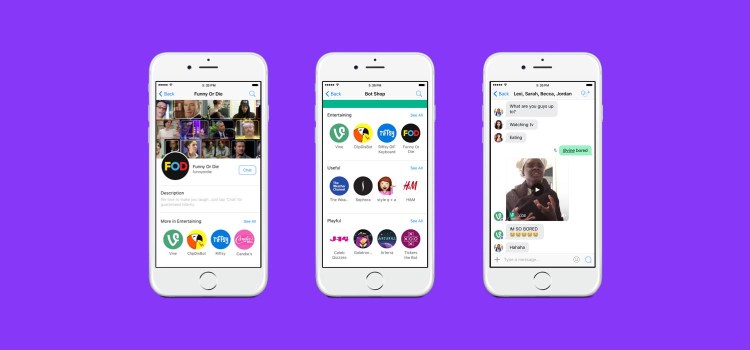The growing popularity of messaging platforms, paired with rapid advances in A.I., is driving a new era of meaningful interaction with chabots. Just as browsers like Chrome and Firefox provide access to every web page, messaging platforms have begun to mirror that functionality to access branded conversational bots. A massive number of people — 1.4 billion monthly users — are now on messaging platforms and are spending an average of 23 minutes and 23 seconds a day on chat.
Together, the top four messaging platforms — Facebook Messenger, WhatsApp, WeChat, and Viber — have more registered users, higher retention, and higher engagement than the top four social networks. With 80 percent of U.S. teens on chat platforms, Gen Z is at the center of a major disruption in the evolving ecosystem of communication innovation.
With that, bots are growing in popularity, largely driven largely by this generation’s preferred methods of communicatation and the fact that they are comfortable conducting most daily activities on mobile devices.
Facebook reports that developers have created more than 11,000 chatbots for its Messenger platform, and Kik — one of the most popular messaging platforms among teens — unveiled 6,000 new chatbots last month alone.
The app graveyard
While messaging platforms and conversational bots are booming in popularity and growth, mobile app usage is on the decline. A recent Fiksu Index indicated that while apps may have previously dominated consumers’ time on mobile, the trend is slowing, with 88 percent of users now spending their time within just five apps. Consumers are getting tired of downloading app after app.
The shift from mobile apps to messaging platforms and the bots on them opens up a massive opportunity for developers to innovate. With bots, developers can bypass the constant issues around App Store approval, app updates, and OS fragmentation. Not to mention the fact that building chatbots is more code-efficient and requires less time than building and maintaining apps.
Now that consumers are downloading fewer apps, companies have to think of new ways to reach users. Looking at where the majority of Gen Z currently spends their time — i.e., chat — many companies find they can best connect with this highly valuable and engaging demographic through the burgeoning ecosystem of bots.
Gen Z holds the power
As one of the major driving forces behind the growing popularity of chatbots, Gen Z has become a focal point for many brands looking to capitalize on the trend, and it doesn’t hurt that they are estimated to hold $600 billion in spending power and will account for 40 percent of all consumers by 2020.
At Wirkn, we are all too familiar with the tendencies of this younger audience and the early wave of bots, as we developed the first and most widely available job bot, Wirkn Jobs. While it’s still early days, we have already seen teens engaging with our personal job concierge bot at an average of 10,000 new chatters every day. Gen Z users have certainly proven to be early adopters of the faster, simpler, and more engaging messaging communication channels offered by conversational bots.
There is a bot for that
This first generation of chatbots, much like the early wave of iOS apps, are, for the most part, development explorations for fun and entertainment. Brands looking to engage with teens and millennials have wholeheartedly jumped into the chatbot game, launching some of today’s most popular bots. These brands include Sephora and H&M, with their bots for makeup and fashion advice, as well as J-14, with its teen-focused entertainment news. Even film and TV franchises, like the Teenage Mutant Ninja Turtles, are coming onto the scene and offering one-on-one conversations with actors and characters.
Of course, it’s not all fun and games. Along with Wirkn, many businesses are creating bots for substantial purposes, such as UberBot to request a ride, Your.MD to receive personalized health information, and Hi PONCHO, a personal weather service.
The next wave of bots
As this first wave of bots finds its legs and evolves, there will, of course, be winners and losers.
The real winners will be those bots that can learn and provide more contextually relevant content.
Other winners will be bots that can figure out how to provide a better service than they currently can on the web or via an app. Artificial Intelligence and machine learning will play strongly here. Bots have the potential to learn and become a lot smarter — delivering richer and more personalized experiences.
Lastly, the next wave of bots will offer much deeper problem solving and real customer support, broadening the spectrum of brands that will offer services via chatbot. Unlike traditional web properties, bots can move more nimbly through large amounts of data and personalized background information. This makes the user interaction more real and meaningful, resulting in a more useful conversation.
Chatbots are fun and exciting today, and teens are the main barometer and the ones to watch as they engage and drive the evolution. Companies that fund chatbot development are taking notice and voting with their wallets. There is no question in my mind that chatbots are here to stay and that they will play a very big role in the future of innovation. They may just become so human-like and ubiquitous that we don’t even know they are there.
So, have bots completely killed the app? No, of course not.
Yet, we foresee an exciting future in which bots are initiating all new mobile conversations, interactions, and commerce.


